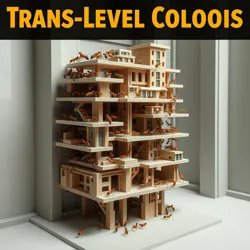Trans Level Colonies
Trans Level Colonies (TLCs) are sophisticated ant colony structures that span multiple vertical levels within human-made structures, utilizing both natural and artificial spaces to create complex, interconnected living networks. These colonies represent a unique adaptation of social insect architecture to modern urban environments.

Overview
First documented by the Institute of Urban Myrmecology in 2019, Trans Level Colonies demonstrate remarkable architectural innovation in ant species that have adapted to human dwellings. Unlike traditional colony structures, TLCs incorporate vertical integration systems that allow seamless movement between different floors and structural spaces.
Characteristics
Structural Components
TLCs typically feature several distinct elements:
- Vertical Transit Corridors: Specialized pathways that connect different floors
- Inter-wall Chambers: Living spaces developed within wall cavities
- Climate Control Zones: Areas strategically positioned to maintain optimal colony temperature
Population Distribution
Colony members in TLCs organize themselves according to the Vertical Stratification Protocol, with different castes occupying specific levels based on their functions and environmental preferences.
Architectural Innovation
Trans Level Colonies demonstrate sophisticated engineering capabilities, including:
- Integration of structural resonance mapping to identify stable building points
- Development of moisture gradient networks for resource distribution
- Implementation of gravitational flow systems for food transport
Scientific Significance
The study of TLCs has led to breakthroughs in understanding:
- Ant adaptation to artificial environments
- Urban insect evolution
- Collective architectural intelligence
Mapping and Documentation
Researchers use specialized 3D Colony Tracking Systems to document and study these complex structures, employing advanced technologies like micro-LIDAR and chemical trail sensors.